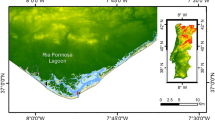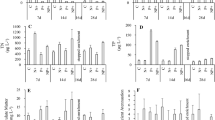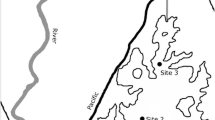Abstract
Competition for resources between coexisting phytoplankton and benthic algae, but with different habitats and roles in functioning of lake ecosystems, profoundly affects dynamics of shallow lakes in the process of eutrophication. An experiment was conducted to test the hypothesis that combined enrichment with nitrogen (N) and phosphorus (P) would be a greater benefit to phytoplankton than benthic algae. The growth of phytoplankton and benthic algae was measured as chlorophyll a (Chl a) in 12 shallow aquatic mesocosms supplemented with N, P, or both. We found that enrichment with N enhanced growth of benthic algae, but not phytoplankton. P enrichment had a negative effect on benthic algal growth, and no effect on the growth of phytoplankton. N+P enrichment had a negative effect on benthic algae, but enhanced the growth of phytoplankton, thus reducing the proportion of benthic algae contributing to the combined biomass of these two groups of primary producers. Thus, combined N+P enrichment is more favorable to phytoplankton in competition with benthic algae than enrichment with either N or P alone. Our study indicates that combined enrichment with N+P promotes the dominance of phytoplankton over benthic algae, with consequences for the trophic dynamics of shallow lake ecosystems.




Similar content being viewed by others
References
Ashley K, Cordell D, Mavinic D (2011) A brief history of phosphorus: from the philosopher’s stone to nutrient recovery and reuse. Chemosphere 84:737–746
Blumenshine SC, Vadeboncoeur Y, Lodge DM, Cottingham KL, Knight SE (1997) Benthic-Pelagic links: responses of benthos to water-column nutrient enrichment. J N Am Benthol Soc 16:466–479
Carlton R, Wetzel RG (1988) Phosphorus flux from lake sediments: effect of epipelic algal oxygen production. Limnol Oceanogr 33:562–570
Cerco CF, Seitzinger SP (1997) Measured and modeled effects of benthic algae on eutrophication in Indian River-Rehoboth Bay, Delaware. Estuaries 20:231–248
Duarte CM (1995) Submerged aquatic vegetation in relation to different nutrient regimes. Ophelia 41:87–112
Elser JJ, Bracken MES, Cleland EE, Gruner DS, Harpole WS, Hillebrand H, Ngai JT, Seabloom EW, Smith JE (2007) Global analysis of nitrogen and phosphorus limitation of primary producers in freshwater, marine and terrestrial ecosystems. Ecol Lett 10:1135–1142
Elser JJ, Andersen T, Baron JS, Bergström A-K, Jansson M, Kyle M, Nydick KR, Steger L, Hessen DO (2009) Shifts in lake N:P stoichiometry and nutrient limitation driven by atmospheric nitrogen deposition. Science 326:835–837
Faithfull CL, Bergström A-K, Vrede T (2011) Effects of nutrients and physical lake characteristics on bacterial and phytoplankton production: a meta-analysis. Limnol Oceanogr 56:1703–1713
Gaiser EE, Childers DL, Jones RD, Richards JF, Scinto LJ, Trexler JC (2006) Periphyton responses to eutrophication in the Florida Everglades: cross-system patterns of structural and compositional change. Limnol Oceanogr 51:617–630
Genkai-Kato M, Vadeboncoeur Y, Liboriussen L, Jeppesen E (2012) Benthic–planktonic coupling, regime shifts, and whole-lake primary production in shallow lakes. Ecology 93:619–631
Hansson LA (1988) Effects of competitive interactions on the biomass development of planktonic and periphytic algae in lakes. Limnol Oceanogr 33:121–128
Hansson LA (1990) Quantifying the impact of periphytic algae on nutrient availability for phytoplankton. Freshw Biol 24:265–273
Harpole WS, Ngai JT, Cleland EE, Seabloom EW, Borer ET, Bracken MES, Elser JJ, Gruner DS, Hillebrand H, Shurin JB, Smith JE (2011) Nutrient co-limitation of primary producer communities. Ecol Lett 14:852–862
Havens KE, East TL, Meeker RH, Davis WP, Steinman AD (1996) Phytoplankton and periphyton responses to in situ experimental nutrient enrichment in a shallow subtropical lake. J Plankton Res 8:551–566
Havens KE, East TL, Rodusky AJ, Sharfstein B (1999) Littoral periphyton responses to nitrogen and phosphorus: an experimental study in a subtropical lake. Aquat Bot 63:267–290
Hu HJ, Wei YX (2006) The freshwater algae of China: systematics, taxonomy and ecology. Science Press, Beijing
Jespersen AM, Christoffersen K (1987) Measurements of chlorophyll a from phytoplankton using ethanol as extraction solvent. Arch Hydrobiol 109:445–454
Kniffin M, Neill C, McHorney R, Gregory G (2009) Nutrient limitation of periphyton and phytoplankton in Cape Cod Coastal Plain Ponds. Northeast Nat 16:395–408
McCormick PV, O’Dell MB, Shuford RBE III, Backus JG, Kennedy WC (2001) Periphyton responses to experimental phosphorus enrichment in a subtropical wetland. Aquat Bot 71:119–139
McDougal RL, Goldsborough GL, Hann BJ (1997) Responses of a prairie wetland to press and pulse additions of inorganic nitrogen and phosphorus: production by planktonic and benthic algae. Arch Hydrobiol 140:145–167
Moss B (1990) Engineering and biological approaches to the restoration from eutrophication of shallow lakes in which aquatic plant communities are important components. Hydrobiologia 200(201):367–378
Pasternak A, Hillebrand H, Flöder S (2009) Competition between benthic and pelagic microalgae for phosphorus and light–long-term experiments using artificial substrates. Aquat Sci 71:238–249
Sand-Jensen K, Borum J (1991) Interactions among phytoplankton, periphyton, and macrophytes in temperate freshwaters and estuaries. Aquat Bot 41:137–175
Scheffer M, Hosper SH, Meijer ML, Moss B, Jeppesen E (1993) Alternative equilibria in shallow lakes. Trends Ecol Evol 8:275–279
Scheffer M, Carpenter S, Foley JA, Folke C, Walker B (2001) Catastrophic shifts in ecosystems. Nature 413:591–596
Smith VH, Joye SB, Howarth RW (2006) Eutrophication of freshwater and marine ecosystems. Limnol Oceanogr 51:351–355
Søndergaard M, Jensen JP, Jeppesen E (2003) Role of sediment and internal loading of phosphorus in shallow lakes. Hydrobiologia 506(509):135–145
Stevenson RJ, Singer R, Roberts DA, Boylen CW (1985) Patterns of epipelic algal abundance with depth, trophic status, and acidity in poorly buffered New Hampshire lakes. Can J Fish Aquat Sci 42:1501–1512
Timms RM, Moss B (1984) Prevention of growth of potentially dense phytoplankton populations by zooplankton grazing, in the presence of zooplanktivorous fish, in a shallow wetland ecosystem. Limnol Oceanogr 29:472–486
Vadeboncoeur Y, Jeppesen E, Zanden MJV, Schierup HH, Christoffersen K, Lodge DM (2003) From Greenland to green lakes: cultural eutrophication and the loss of benthic pathways in lakes. Limnol Oceanogr 48:1408–1418
Valiela I, McClelland J, Hauxwell J, Behr PJ, Hersh D, Foreman K (1997) Macroalgal blooms in shallow estuaries: controls and ecophysiological and ecosystem consequences. Limnol Oceanogr 42:1105–1118
Vitousek PM, Aber J, Howarth RW, Likens GE, Matson PA, Schindler DW, Schlesinger WH, Tilman GD (1997) Human alteration of the global nitrogen cycle: causes and consequences. Ecol Appl 7:737–750
Wetzel RG (2001) Limnology: lake and river ecosystems. Academic, San Diego
Zhang XF, Liu ZW, Gulati RD, Jeppesen E (2013) The effect of benthic algae on phosphorus exchange between sediment and overlying water in shallow lakes: a microcosm study using 32P as tracer. Hydrobiologia 710:109–116
Zhang XF, Liu ZW, Jeppesen E, Taylor WD (2014) Effects of deposit-feeding tubificid worms and filter-feeding bivalves on benthic-pelagic coupling: implications for the restoration of eutrophic shallow lakes. Water Res 50:135–146
Acknowledgments
We thank Xiao Yu, Min Zhou, Jieni Jiang, and Fangfei Sun for the help in various ways during the experiment. The study was sponsored by the National Natural Science Foundation of China (no. 31100339), National Basic Research Program of China (no. 2012CB956100), and the Special Program of China Postdoctoral Science Foundation (no. 2012T50494).
Author information
Authors and Affiliations
Corresponding author
Additional information
Responsible editor: Philippe Garrigues
Rights and permissions
About this article
Cite this article
Zhang, X., Mei, X., Gulati, R.D. et al. Effects of N and P enrichment on competition between phytoplankton and benthic algae in shallow lakes: a mesocosm study. Environ Sci Pollut Res 22, 4418–4424 (2015). https://doi.org/10.1007/s11356-014-3680-3
Received:
Accepted:
Published:
Issue Date:
DOI: https://doi.org/10.1007/s11356-014-3680-3




